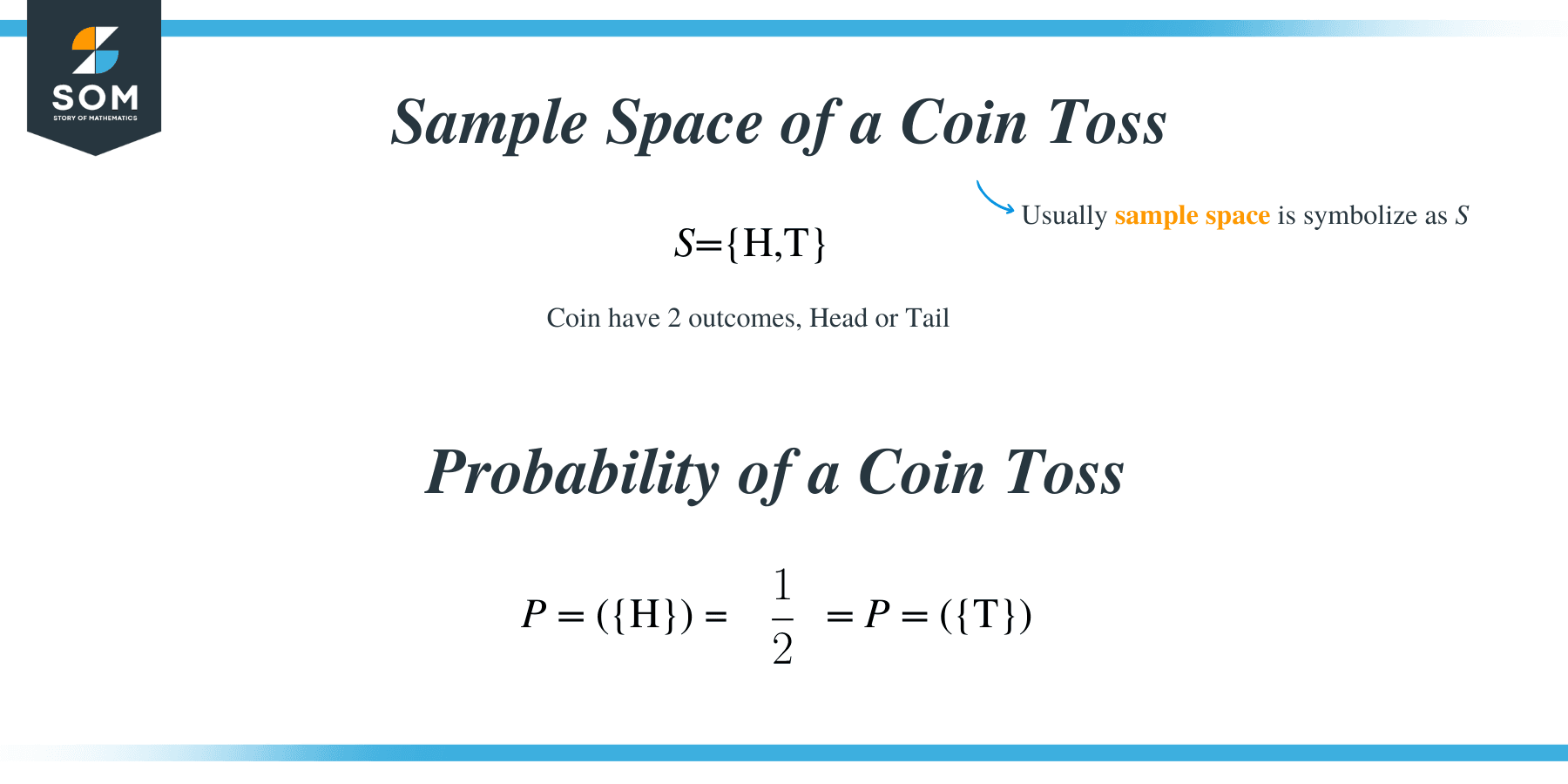- Home
- >
- Coin flip probability – Explanation & Examples
JUMP TO TOPIC
Coin Flip Probability – Explanation & Examples
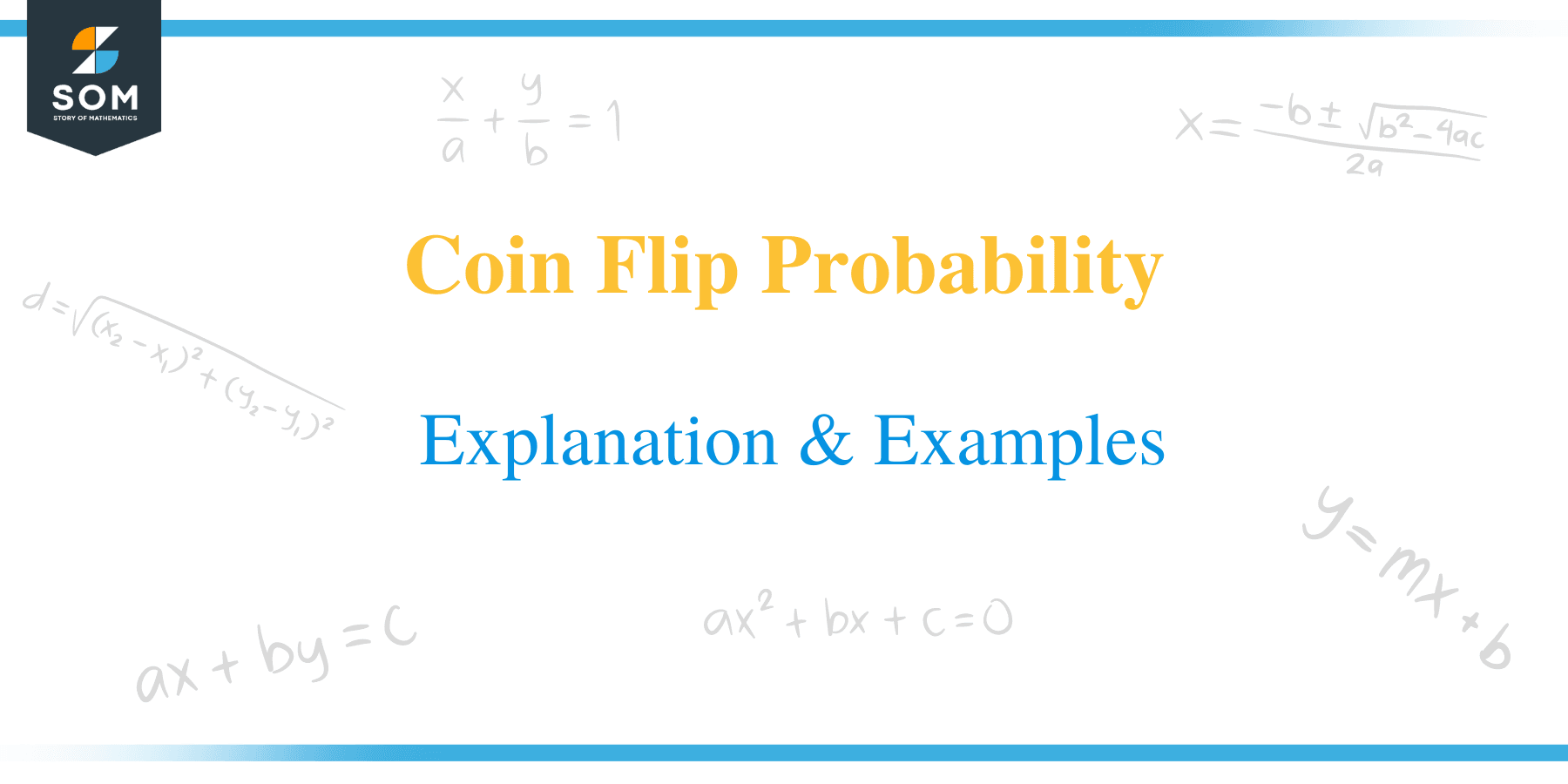 The image of a flipping coin is invariably connected with the concept of “chance.” So it is no wonder that coin flip probabilities play a central role in understanding the basics of probability theory.
The image of a flipping coin is invariably connected with the concept of “chance.” So it is no wonder that coin flip probabilities play a central role in understanding the basics of probability theory.
Coin flip probabilities deal with events related to a single or multiple flips of a fair coin. A fair coin has an equally likely chance of coming up Heads or Tails.
It might be advisable to refresh the following concepts to understand the material discussed in this article.
After reading this article, you should understand:
- What is meant by coin flip probabilities.
- How to calculate probabilities associated with multiple coin flips using sample spaces.
- How to calculate probabilities associated with multiple flips using tree diagrams.
- How to calculate probabilities associated with multiple flips using the formula for probabilities of independent events.
How to calculate the probability of coin flips
To understand how to calculate the probability of coin flips, we first need to discuss the concept of sample spaces.
Sample Spaces:
A sample space is a set (i.e., collection) of all possible events in a probabilistic experiment.
For example, when we flip a coin, we can either get Heads ($H$) or Tails ($T$). So the sample space is $S=\{H, T\}$. Every subset of a sample space is called an event. For a single toss of a coin, we can make four subsets of the sample space, i.e., the empty set $\Phi$, $\{H\}$, $\{T\}$ and the sample space itself $\{H, T\}$. The probability of an empty set (i.e., neither Heads nor Tails) is always zero, and the probability of the entire sample space ( i.e., either Heads or Tails) is always $1$. For any other given event $E$ (i.e., a subset of $S$), we can use the following formula
$\fbox{$P(E) = \frac{\textrm{Number of elements in E}}{\textrm{Number of elements in S}}$}$
What is the probability of a coin landing on heads
To calculate the probability of the event $E=\{H\}$, we note that $E$ contains only one element and sample space $S$ contains two elements, so
$P(\{H\}) = \frac{1}{2}$.
What is the probability of a coin landing on tails
Using a similar argument, the probability of the event $E=\{T\}$ is given as
$P(\{T\}) = \frac{1}{2}$.
How to calculate the probability of multiple coin flips
Only a small number of questions can be asked about the probabilities associated with a single flip of a coin. However, we can ask many interesting questions if we consider multiple flips of a coin (Note: we get the same sample space whether we flip a single coin multiple times or flip multiple coins simultaneously).
Let us consider the experiment of flipping a fair coin twice: we can write the corresponding sample space as $S = \{HH, HT, TH, TT\}$. Let us find the probabilities associated with this experiment.
Example 1: A fair coin is flipped twice. What is the probability of the following events:
- Getting at least one Heads.
- Getting at most one Heads.
- Getting Tails twice.
- Getting no Tails.
Solution:
1) Getting at least one Heads
Let $E$ be the event that we get at least one head. We can see from the sample space that there are three possibilities of getting at least one Head, i.e., the first flip is Heads and second Tails, the first flip is Tails and the second head, and both flips are Heads. Hence, $E = \{HT, TH, HH\}$. Note that there are three elements in $E$ and a total of 4 elements in $S$; therefore,
$P(\textrm{Atleast one Heads}) = P(E) = \frac34$.
2) Getting at most one Heads
Let $E$ be the event that we get at most one head. Then, $E=\{HT, TH, TT\}$. We note that $E$ has three elements and sample space $S$ has 4 elements, so
$P(\textrm{At most one Heads}) = P(E) = \frac34$.
3) Getting Tails twice
Let $E$ be the event that we get tails twice. Then, $E=\{TT\}$. We note that $E$ has one element and sample space $S$ has 4 elements, so
$P(\textrm{two tails}) = P(E) = \frac14$.
4) Getting no Tails
Let $E$ be the event that we get no tails. Then, $E=\{HH\}$. We note that $E$ has one element and sample space $S$ has 4 elements, so
$P(\textrm{no tails}) = P(E) = \frac14$.
Example 2: A fair coin is flipped three times. Make the sample space and find the probabilities of the following events:
- Getting all Heads.
- Getting all Tails.
- Getting an even number of Tails.
- Getting more Heads than Tails.
Solution:
We can write the sample space as $S=\{HHH,HHT,HTH,HTT,THH,THT,TTH,TTT\}$.
1) Getting all Heads
Let $E$ be the event that we get all heads. We can see from the sample space that there is only one outcome with three heads, i.e., $E = \{HHH\}$. So the probability is
$P(E) = \frac{\textrm{Number of elements in E}}{\textrm{Number of elements in S}}=\frac18$.
2) Getting all tails
Let $E$ be the event that we get all tails. We can see from the sample space that there is only one outcome with all tails, i.e.,$E = \{TTT\}$. So the probability is
$P(E) = \frac{\textrm{Number of elements in E}}{\textrm{Number of elements in S}}=\frac18$.
3) Getting an even number of tails
Let $E$ be the event that we get an even number of tails. We can see from the sample space that there are three outcomes with an even number of tails, i.e., $E = \{HTT, THT, TTH\}$. So the probability is
$P(E) = \frac{\textrm{Number of elements in E}}{\textrm{Number of elements in S}}=\frac38$
4) Getting more heads than tails
Let $E$ be the event that we get more heads than tails. We can see from the sample space that four outcomes have more heads than tails, i.e., $E = \{HHH, HHT, HTH, THH\}$. So the probability is
$P(E) = \frac{\textrm{Number of elements in E}}{\textrm{Number of elements in S}}=\frac48=\frac12$.
Probabilities of multiple coins flip using tree diagrams
It is more convenient to rely on tree-diagrams to find multiple coin flip probabilities than to use the sample space method in many cases. We illustrate the concept using examples
Example 3:
A coin is flipped three times. Draw a tree diagram that represents all possible outcomes. Also, calculate the probabilities of the following events:
- Getting three Heads.
- Getting two Tails.
- Getting no Heads.
- Getting at least one Tails.
Solution:
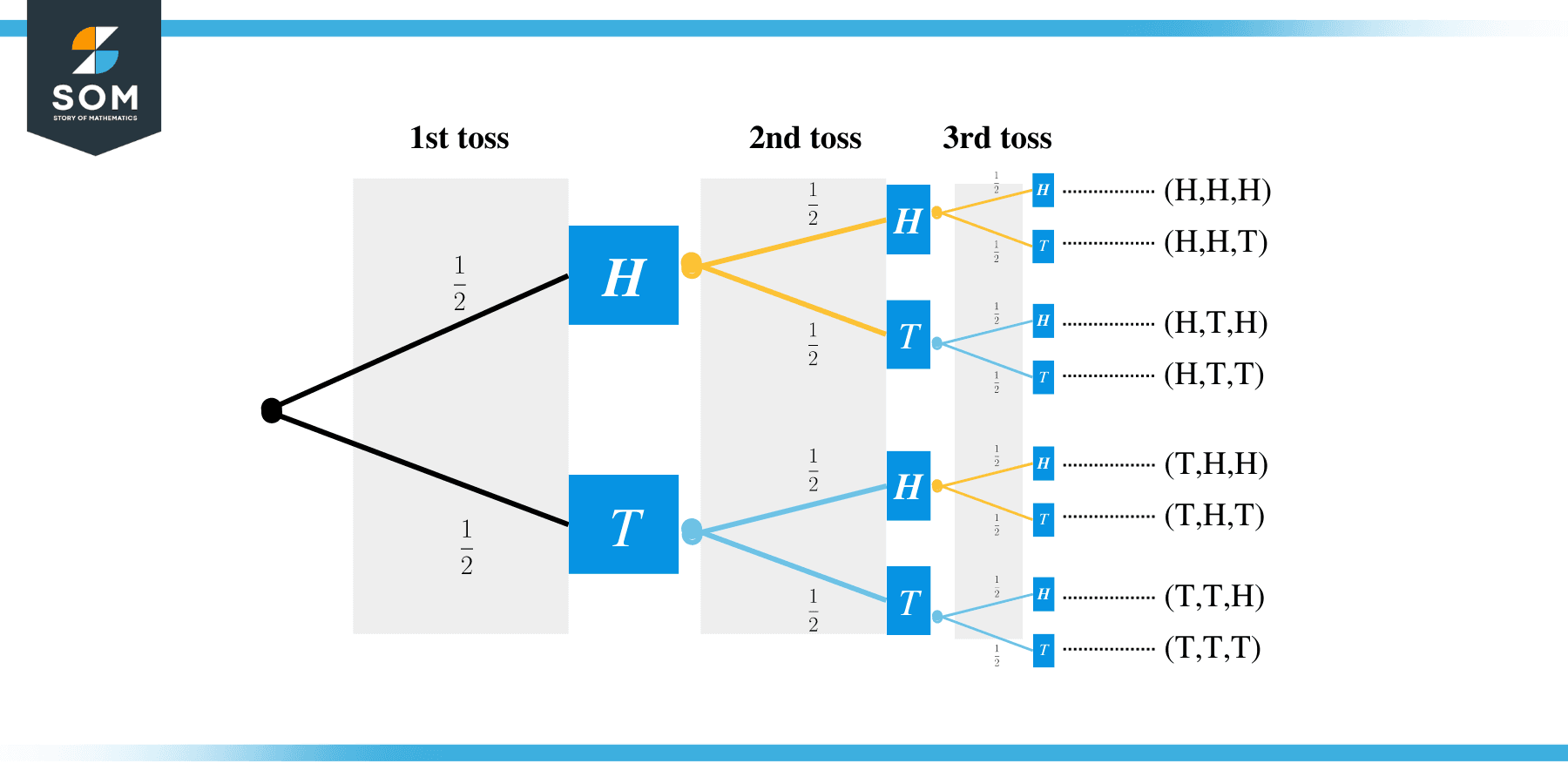
1) Getting three Heads
From the tree diagram, we can see that only one outcome corresponds to the event of getting all three heads. To get probabilities out of a tree diagram, we multiply the probabilities along the branches. So, the probability of getting three heads is
$P(\textrm{Three Heads}) = \frac12 \times \frac12 \times \frac12=\frac18$.
2) Getting two Tails
We can see that there are three events that have two tails,i.e., $E1=\{TTH\}$, $E2=\{HTT\}$ and $E3=\{THT\}$. So we will add the probabilities of each event:
$P(E1)=\frac12 \times \frac12 \times \frac12=\frac18$.
$P(E2)=\frac12 \times \frac12 \times \frac12=\frac18$.
$P(E3)=\frac12 \times \frac12 \times \frac12=\frac18$.
So we can write the probability of getting two tails as
$P(\textrm{Two Tails}) = P(E1)+P(E2)+P(E3) = \frac18+\frac18+\frac18=\frac{3}{8}$.
3) Getting no Heads
From the tree diagram, we can see that the probability of getting no Heads is
$P(\textrm{no Heads}) = \frac12 \times \frac12 \times \frac12=\frac18$.
4) Getting at least one Tails
We can see that there are six events that have at least one tails, i.e., $E1=\{TTH\}$, $E2=\{HTT\}$, $E3=\{THH\}$, $E4=\{THT\}$, $E5=\{TTH\}$, and $E6=\{TTT\}$. So we will add the probabilites of each event:
$P(E1)=\frac12 \times \frac12 \times \frac12=\frac18$.
$P(E2)=\frac12 \times \frac12 \times \frac12=\frac18$.
$P(E3)=\frac12 \times \frac12 \times \frac12=\frac18$.
$P(E4)=\frac12 \times \frac12 \times \frac12=\frac18$.
$P(E5)=\frac12 \times \frac12 \times \frac12=\frac18$.
$P(E6)=\frac12 \times \frac12 \times \frac12=\frac18$.
So we can write the probability of getting at least one tails as
$P(\textrm{Two Tails}) = P(E1)+P(E2)+P(E3)+P(E4)+P(E5)+P(E6) $
$= \frac18+\frac18+\frac18+\frac18+\frac18+\frac18=\frac{6}{8}=\frac{3}{4}$.
Multiple flips and independent events
When the number of flips is large, both the tree diagrams and the sample space methods might become too cumbersome. In such cases, we can rely on the fact that multiple flips are independent events. Two events are said to be independent if one event does not affect the probabilities of the other. When we flip a coin multiple times, the outcome of any one flip does not affect the other flips’ outcomes, so the events are independent. Remember from basic probability theory that when two events, say $E1$ and $E2$, are independent, the probability of the event $E1$ AND $E2$ is given as
$P(E1\; \textrm{AND}\; E2) = P(E1) \times P(E2)$
We can use the above expression to solve multiple coin flips’ problems, as shown in the examples below.
Example 4: A fair coin is flipped twice. What is the probability of the following events:
- Getting at least one Heads.
- Getting at most one Heads.
- Getting Tails twice.
- Getting no Tails.
Solution:
We have already solved this example using the sample space method. Now, we solve it using the concept of independent probabilities.
1) Getting at least one Heads
We first find the probability of finding no Heads, i.e., the probability that both flips are Tails.
$P(\textrm{First flip is Tails}) = \frac12$.
$P(\textrm{Second flip is Tails}) = \frac12$.
$P(\textrm{First flip is Tails AND Second flip is Tails}) = \frac12 \times \frac12 = \frac14$.
Since both flips are independent, so we have multiplied the probabilities. Now, from basic probability theory, we know that
$P(\textrm{Atleast one Heads}) = 1 – P(\textrm{Getting no Heads}) = 1 – \frac14 = \frac34$.
2) Getting at most one Heads
Three possibilities correspond to getting at most one Heads, i.e., $\{TT\}$, $\{HT\}$, and $\{TH\}$. Using the concept of independent events, we evaluate each possibility’s probability and then add to get the final answer.
$P(\{TT\}) = \frac12 \times \frac12 = \frac14$.
$P(\{HT\}) = \frac12 \times \frac12 = \frac14$.
$P\{TH\} = \frac12 \times \frac12 = \frac14$.
$P(\textrm{At most one Heads}) = P(\{TT\}) + P(\{HT\}) + P(\{TH\}) = \frac14 + \frac14 + \frac14 = \frac34$.
3) Getting Tails twice
Getting Tails twice is the same as the first flip is Tails, AND the second flip is Tails. Therefore,
$P(\textrm{getting Tails twice}) = P((\textrm{first flip is Tails}) \times P(\textrm{Second flip is Tails) = \frac12 \times \frac12 = \frac14$.
4) Getting no Tails
$P(\textrm{Getting no Tails}) = P(\textrm{First flip is not Tails}) \times P(\textrm{Second flip is not Tails})$.
$P(\textrm{First flip is not Tails}) = 1 – P(\textrm{First flip is Tails}) =1 -\frac12 = \frac12$.
Similarly,
$P(\textrm{Second flip is not Tails}) = \frac12$. Hence,
$P(\textrm{Getting no Tails}) = \frac12 \times \frac12 = \frac14$.
Example 5: A coin is flipped $10$ times. What are the probabilities of getting:
- No Heads
- At least one Heads.
Solution:
Note that we are flipping the coin $10$ times. Both the sample space and the tree diagram will make the question too complex. However, using the concept of independent events, we can easily solve this question.
$P(\textrm{getting at least one Heads}) = 1 – p(\textrm{getting no Heads)\}$.
Now, getting no Heads is the same as getting Tails $10$ times in $10$ flips. In each flip, the probability of getting a Tails is $\frac12$. Since each flip is independent, so the probability will get multiplied, i.e.,
$P(\textrm{10 tails in 10 flips}) = \left(\frac12\right)^{10}$. Finally,
$P(\textrm{getting at least one Heads}) = 1 – \left(\frac12\right)^{10} = 0.999$.
Example 6: A coin is flipped multiple times. What is the probability that the first Heads come up on the 4th flip?
$P(\textrm{first Heads on 4th flip}) = P(\textrm{1st Tails AND 2nd Tails AND 3rd Tails AND 4th Heads})$.
$P(\textrm{first Heads on 4th flip}) = P(\textrm{1st Tails}) \times P(\textrm{2nd Tails}) \times P(\textrm{3rd Tails}) \times P(\textrm{4th Heads}) $.
$P(\textrm{first Heads on 4th flip}) = \frac12 \times \frac12 \times \frac12 \times \frac12 = \frac{1}{16}$.
Practice Questions:
- A coin is flipped 4 times. Draw a tree diagram to show the probability that three heads and one tail appear?
Three fair coins are tossed simultaneously. What is the probability of the following:
- The first is the head, and the second is the tail.
- Three heads in a row.
- Two tails and one head.
Three fair coins are tossed simultaneously. Use a tree diagram to determine the probability of getting:
- At least 2 Tails.
- At most two Heads.
- No Tails at all.
- A fair coin is tossed 5 times. What is the probability of the following events?
- At least one Heads.
- No Tails.
- The coin comes up Heads for the first time after 3 attempts.
- First Heads in the first three attempts.
Answers:
1)
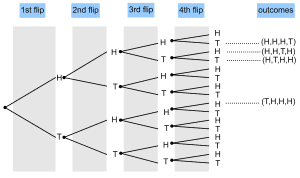
$P(\textrm{3 Heads and 1 Tails}) = \frac{4}{16} = \frac14$.
2)
- $\frac14$.
- $\frac18$.
- $\frac18$.
3)
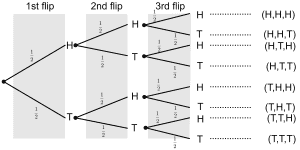
$P(\textrm{atleast two Tails}) = P(T,T,H) + P(T,H,T) + P(H,T,T) + P(T,T,T) = \frac12$.
$P(\textrm{at most two Heads}) = 1 – P(H,H,H) = \frac78$.
$P(\textrm{No tails}) = P(H,H,H) = \frac18$.
4)
- $0.968$.
- $0.03125$.
- $\frac18$.
- $0.875$.

